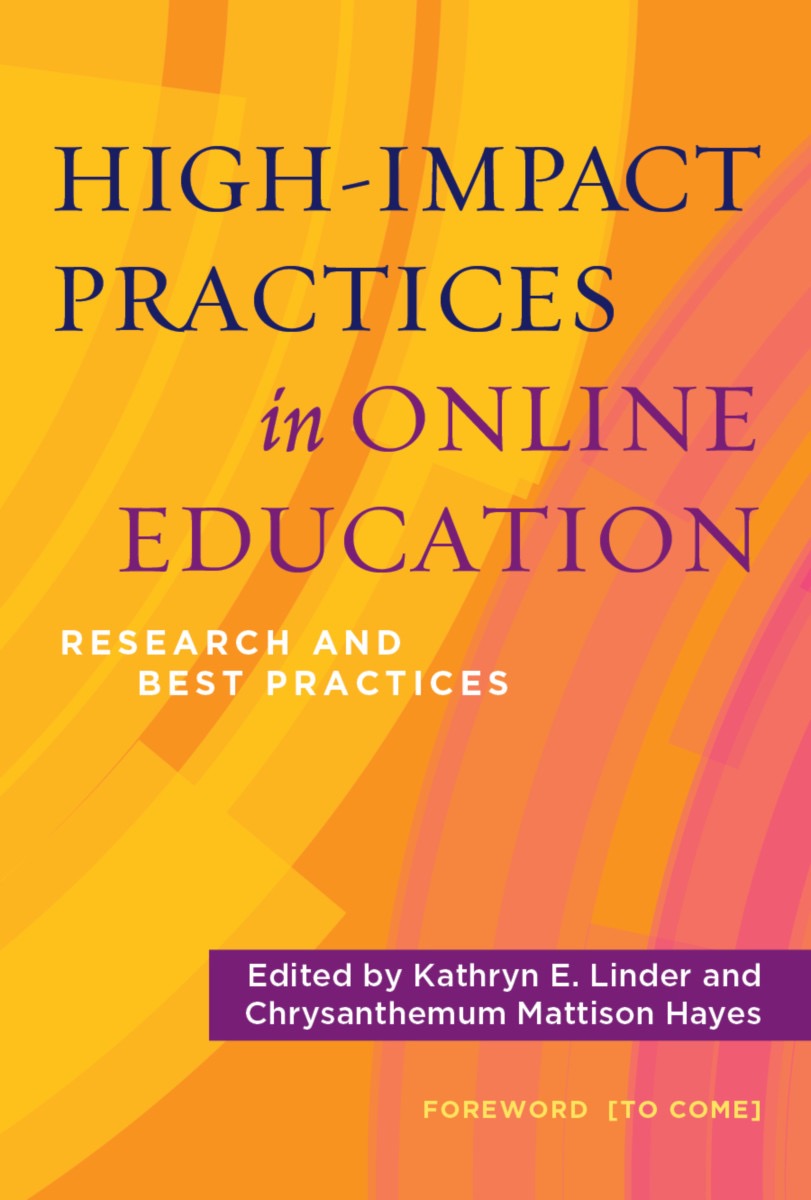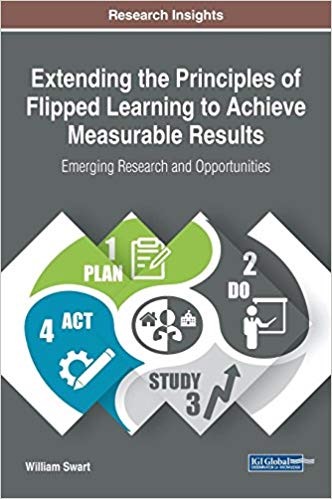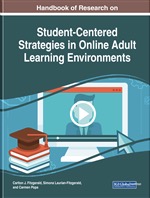online learning
Select an item by clicking its checkbox
Date Reviewed: April 15, 2020
What are the potential benefits of high-impact practices (HIPs) for online education? That is the key question addressed in this well-researched collection of essays. Whether the reader is new to innovative theory and techniques in online education or an experienced distance educator, they will find a valuable resource here. Each contributor provides a helpful short list of key takeaways and a solid bibliography at the end of their chapter. The introduction and conclusion by the editors, Linder and Hayes, set the framework for the discussion and aptly describe possible future directions for teaching online, blended, or face-to-face courses.
High-Impact Practices in Online Education reads like a dynamic conversation on research with practical recommendations for how to strengthen a variety of teaching contexts. Each topic selected for inclusion covers a specific high-impact educational practice. That list was largely identified in 2008 by George D. Kuh as ten critical components of undergraduate education. First-year seminars, learning communities (LCs), writing-intensive courses, and internships were among those featured components. These practices are still considered high-impact, but newer practices, such as ePortfolios, have been added in subsequent years. All have become part of developing educational strategies to impact student retention and graduation rates.
So, where will readers find what they most need in this collection? For some, a particular topic will draw their attention. My suggestion is to resist that impulse. Try, instead, reading the introduction and conclusion before sampling individual chapters. Understanding the context for the conversation about HIPs matters. The research and literature in this emerging field has been somewhat scattered, but a representative sample is nicely gathered and incorporated into this single volume.
There are no chapters specifically on theological education or religious studies. That said, there is much of worth to educators in those disciplines. For example, June Griffin’s “Writing-Intensive Classes” or Pamela D. Pike’s “Internships” speak directly to theological and religious educators. The same can be said about Stefanie Buck’s “High Impact Practices and Library and Information Resources.” No doubt other readers will discover other favorites as well. Remember that any one of these chapters could make a dramatic difference in most teaching and student learning.
Is there one overarching idea offered as a takeaway? Yes, and it is that best practice principles are, in the end, more important than modalities. That is a valuable point to have in mind as exciting new technologies continue to emerge.
Date Reviewed: April 15, 2020
As higher education continues to grapple with expanding online coursework in meaningful ways, faculty must confront a perennial question: how can online coursework mirror the rigor of in-person classes while preserving the flexibility that makes online learning attractive to students? In Extending the Principles of Flipped Learning to Achieve Measurable Results: Emerging Research and Opportunities, William Swart argues that flipped learning has the potential to balance these demands by winnowing the transactional distance, a barrier to student engagement, that is common in traditional coursework.
In traditional learning, a lecture typically occurs in class and homework extends beyond the classroom; conversely, flipped learning requires students to study course material at home, including recorded lectures, before engaging in collaborative, problem-solving activities in class. By flipping the traditional model of higher education, flipped learning allows students to invest more deeply in their coursework while simultaneously receiving feedback and peer support in class.
While flipped learning may be alluring, enacting such a dramatic reordering requires resources, knowledge, and tools that most faculty do not possess. Written in a straightforward, practical style, Swart’s text provides a viable throughway for faculty members hoping to enact a flipped classroom.
Swart begins his exploration of the concept by reviewing the proliferation of online coursework and noting the near-universal agreement among university faculty regarding the disparity of quality in online learning versus face-to-face learning. As an antidote to this pattern, Swart touts the considerable benefits that flipped learning affords students, instructors, and college administrators. Following this introductory material, the text grounds the Plan-Do-Study-Act (P-D-S-A) cycle as the primary vehicle for introducing, executing, and maintaining a flipped classroom. This cycle, originating from business and management, ensures that meaningful learning occurs throughout a new intervention, rather than relying solely on outcome data to judge the effectiveness of an intervention.
The heart of the text unpacks each step of the PDSA cycle and its use in a flipped classroom, offering practical advice and data to support those wishing to use the flipped model. This occurs through direct discussion of the model and an embedded case study that illustrates core concepts. Before closing with an exploration of possible future research, Swart also includes candid discussion of the challenges—both anticipated and unanticipated—that flipped learning often produces. As Swart notes, while there is positive evidence regarding student preferences, achievement, and satisfaction concerning flipped learning, there is a paucity of research documenting its role in promoting other desirable values in students.
This text adds to a growing body of research explicating the promise of flipped learning within K-12 and higher education. Particularly for faculty members in theological education or religious studies in a liberal arts setting, this text provides short-term and lasting benefits. Swart’s thorough unpacking of flipped learning delivers a robust catalog of research-based, practical advice for enacting this model. Perhaps most valuable for these faculty is the opportunity for students to engage with weighty ideas in a collaborative manner after having initial, independent preparation.
Date Reviewed: April 15, 2020
Adult learners are different than younger learners. These groups do, however, share some interests and learning similarities; for instance, both are motivated to use technology in learning. Yet adult learners often have additional challenges using technology because of their late involvement with the digital world. Older adult learners’ participation in online learning and continuing education pose institutional, situational, and dispositional challenges.
Online learning provides particular possibilities for adult learners, thereby allowing them to cope with specific adult learning demands. It helps adult students to maintain some sustainability while navigating new technological terrains. Adult learners may have particular learning issues and challenges arise from time to time.
The Handbook of Research on Student-Centered Strategies in Online Adult Learning Environments was developed for educators who work with adult learners in online programs. It is a book primarily focused on helping teachers by offering specific ideas for working with students in online environments and serving as a guide for structuring learning experiences for people at different stages of development.
The book comprises 22 chapters organized in four sections. Section 1, “Integrating Educational Practices into Online Learning,” provides insights into how educators can link natural learning tendencies in teaching to students’ learning. Furthermore, it highlights competency-based education and the position of student-centered online learning. Section 2, “Adult Learners and Learning,” discusses andragogy in relation to the transitions in knowledge acquisition, focusing on concepts of digital natives and digital immigrants. Discourse on preparing the efficient teacher in the age of information and communication technology is foregrounded in Section 3, “Professional Learning.” For instance, Chapter 14, “A Guide to Professional Learning for Secondary Mathematics Teachers,” explores the impact of a professional learning program on mathematics teachers’ self-efficacy. Section 4, “Student-Centeredness and Collaboration,” provides an overview of collaborative learning as well as student-centered online learning.
This handbook also provides arguments on converting theoretical frameworks into practical work in an online classroom or any other digital context. The chapters are organized subsequently in a rational order, yet the reader can start with any chapter of potential interest. However, the discourse on neoliberalism, along with austerity, and their impact—on online education generally, and online adult education particularly—is absent. Furthermore, the counter-argument which debates that online learning should be accepted with much caution receives only 15 pages. Moreover, while Dan Patroc argues that insufficient non-verbal communication is a major drawback in online learning, non-verbal communication receives only one paragraph. Overall, the editors and authors provide a remarkable contribution to the literature on online adult education. Handbook of Research on Student-Centered Strategies in Online Adult Learning Environments is highly recommended for adult educators, online trainers, researchers, and policymakers.
When we engage our teaching world online, let me encourage you to start where you are. It is not about the tech, gear and gadgets. It is about vision, imagination and design. In this vlog I show you my setup, my online classroom and how I think about this space. ...
When we first move into online classroom spaces, we often miss the dynamic energy of gathered bodies in a familiar location. We lose the immediate gratification of watching in real time as new knowledge “clicks” for students in discussions and class activities. Online classrooms may initially feel sterile, artificial, and ...




